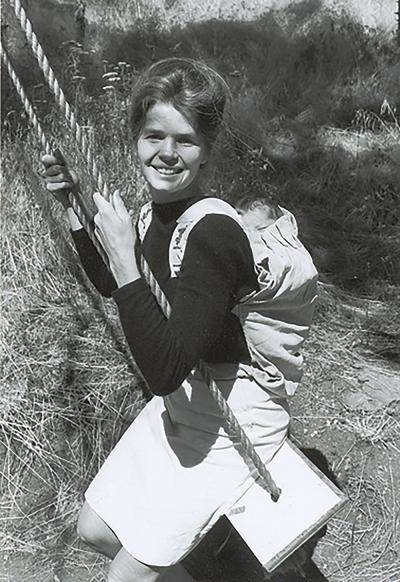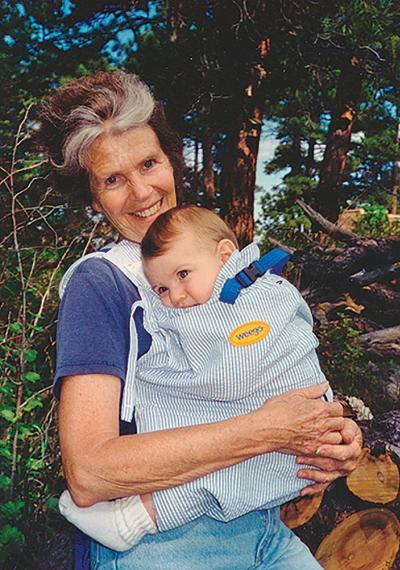Our world: Mother of invention
Ann Moore is a nurse who was an early volunteer with the Peace Corps. She’s also an inventor – recognized by the Wall Street Journal as one of the nation’s most influential – whose best-known product is the Snugli, a contraption that lets parents carry their infants against their chests or backs. Moore is quick to acknowledge that the Snugli was inspired by an age-old practice of mothers in Togo.
“Anything that we can do to get babies and parents closer together to contribute to trust and bonding is so important for emotional health,” says Moore, who along with her husband, Mike, is a member of the Rotary Club of Evergreen, Colorado.


Ann Moore poses with the Snugli in the 1960s and in the 2000s with a Weego, which improved on the Snugli’s design.

In 1962, Moore was teaching pediatric nursing at Columbia University’s Babies Hospital in New York. The chief residents at the hospital were organizing the first Peace Corps team to go to Togo and recruited her to join. “I was so excited. I thought, ‘The more we can get Americans out into other cultures, the healthier we’ll be as a country,’” she says.
On the first day of training, which took place at Howard University in Washington, D.C., she met another volunteer, Mike Moore. “He was my French teacher,” she says. “I was from a farm in Ohio – we didn’t speak much French there.”
Six weeks later, they were engaged, and they married two weeks after that. They went to Togo, where Ann was part of a medical team working in preventive medicine and hygiene. She recalls visiting crowded marketplaces in Togo and never hearing a baby cry. The reason the infants were so content, she realized, was that they were being held close to their mothers – either being breast-fed or carried securely on the mother’s back – by means of a fabric sling.
“When we came back from our Peace Corps assignment in 1964, I was very pregnant,” Moore says. “About a month later, our baby was born and I wanted to carry her the way we had observed with the Togolese mothers.”
The alignment of Moore’s professional work in pediatrics and her personal experience resulted in her most famous invention. She enlisted her mother to help fashion what later became the Snugli, a sort of pouch with leg holes, padding, and adjustable straps. Friends who saw Moore carrying her infant daughter in it immediately wanted one, and then their friends wanted one, and the idea took off.
The Snugli was revolutionary in the mid-1960s, when breast-feeding was just gaining recognition among child-rearing experts as important for nutrition as well as for mother-child bonding. Columbia University conducted a study that found that babies carried in Snuglis exhibited longer eye contact, better language skills, and more emotional security. Low-birth-weight babies also gained weight faster.
The Moores sold the Snugli in 1985. Around the same time, a respiratory therapist asked Moore if she could make something that would allow patients to carry oxygen tanks, and that led to Air Lift, a company that makes soft-sided carriers for oxygen canisters and high-tech instruments. Their oxygen-cylinder backpack helps people who are dependent on supplemental oxygen to be more active. Moore continued to develop related products, including carrying cases for other medical gear.
In the 1990s, Moore developed a baby carrier called the Weego that featured more adjustable straps and other refinements on her original idea.
Moore says her dedication to making a positive impact in the world can be traced to her childhood on that farm in Ohio, where she was raised in the Dunkard Brethren Church, a group similar to Mennonites in that they dress plainly, live simply, and don’t use certain modern devices. (Her parents were eventually excommunicated for using a radio.)
In high school and college, Moore had her first international experiences, working through the related Church of the Brethren. “I worked in two international camps, one in Morocco and one in Germany, where kids come from all over the world and work together,” she says. “So those influences instilled this wonderful feeling of how we’re all interconnected on this earth.”
Rotary International has a partnership with the Peace Corps. Learn more
The Moores joined the Evergreen Rotary Club after Mike approached the club for a grant related to a singing group they belong to. “Within a week they asked him to join Rotary,” Ann says. “Both of us thought Rotary was a kind of old-white-guys thing, and then when we learned about it, it was like an exciting extension of our Peace Corps work – there was so much international emphasis.”
The couple have been active in seeking to connect Rotarians with returning Peace Corps volunteers. “It is such a natural continuation of a Peace Corps volunteer’s experience once they return to get involved, especially in the international part of Rotary,” Moore says.
And Rotary has brought them full circle. “About six or seven years ago we went with Rotary to Ghana to do polio vaccination,” Moore recalls. “We drove to Togo, to the village where we were in the Peace Corps. It was a beautiful experience to go back.”
And she continues to hear from people grateful for the Snugli. “At an International Women’s Day lunch recently, a woman thanked me for the Snugli. Years ago, she had gone to China to pick up her adopted baby from an orphanage, and she carried this new baby in her Snugli for two weeks continuously. That baby is now a teenager and is returning to China to visit and work in that orphanage this summer. Isn’t that terrific?”
— Nikki Kallio
• Read more stories from The Rotarian
